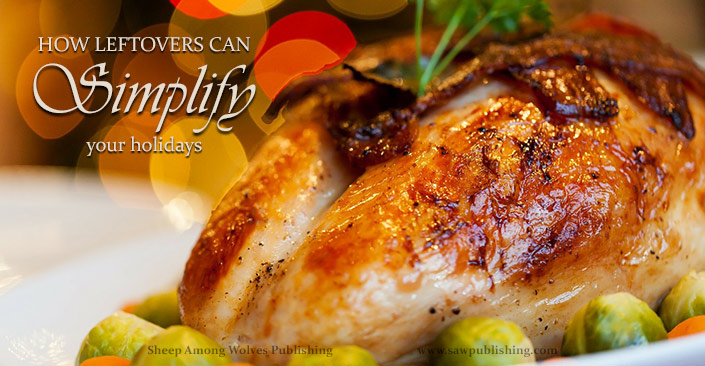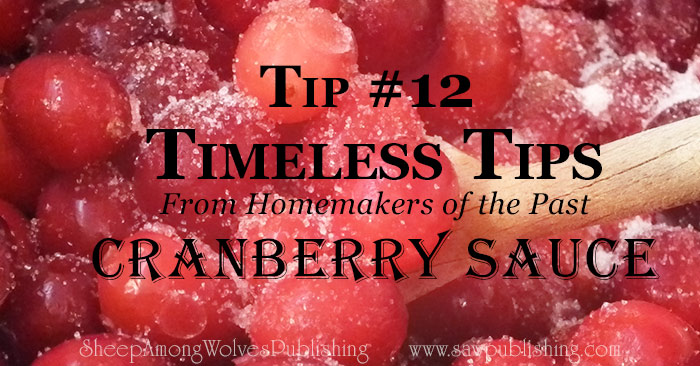How Leftovers Can Simplify Your Holidays

Do you ever feel like Christmas meals are a bit of a rollercoaster? One evening you’re dining on roast turkey with six side dishes, two days later you’re ordering in pizza because you can’t find a thing in the fridge.
Well, maybe its not quite true that you can’t find anything in the fridge. There’s probably a turkey carcass, and a little remnant from each of the six side dishes. But after eating turkey sandwiches for a Christmas evening snack, warmed-up potatoes for Boxing Day breakfast, re-heated leftovers for Boxing Day lunch, and (dare we suggest) leftover-leftovers for Boxing Day dinner—most of us don’t have the moral courage to dish up another meal of nostalgic Christmas fare.
As today’s Timeless Tip demonstrates, leftovers can minimize, instead of adding to, your holiday stress. In Cookery For Little Girls, Olive Hyde Foster highlights the wide variety of appetizing dishes which can be made from odds and ends.
Don’t Be Ashamed of Using Leftovers
We sometimes have a feeling that the perfect homemaker doesn’t really have any leftovers. This is a ridiculous theory, when you think about it. What cook can estimate her family’s appetite that accurately? We can probably avoid cooking twice as much as anyone will eat. (If we really want to! And by the end of this post, you’ll realize that’s a big IF.)
But no one can escape the occasional cup of broccoli, or scoop of spaghetti, or slice of cold roast beef that just doesn’t get eaten at the meal.
Olive Hyde Foster begins her chapter on leftovers with the statement that, “Every mother, in teaching her little daughter to cook, should impress upon her two essential points—economy and neatness.”
“Following the instructions regarding cleanliness, and of equal importance, is the lesson in the economical use of materials on hand . . . In small families these bits can be made into attractive dishes for luncheon, or, in case of an unexpected guest, converted into an additional course.”
Leftovers Save Money
Obviously, wasted leftovers are money down the drain. A wise use of odds and ends saves money on two scores.
1) Using leftovers saves money because it keeps you from throwing out food you have already bought for the first meal.
2) Using leftovers saves money because it lets you cut back on the grocery bill for the second meal.
 Leftovers Save Time
Leftovers Save Time
Incorporating leftovers—particularly leftover meat and vegetables—into your meals usually means a substantial cut-down on prep-time. Throwing a container of cold sliced potatoes into your soup pot takes less than a minute. Pealing, chopping, and then waiting to cook the same potatoes from raw is a much more time-consuming enterprise.
During the Holidays, more than at any other season, our money and our time are at a premium.
Use the Garnish of Creativity
Olive Hyde Foster claims that cooking with leftovers is a much greater test of skill than cooking with new ingredients.
“Anyone can take a recipe calling for all fresh materials and, with a little care, turn out a successful dish; but it takes a culinary artist to successfully work up the odds and ends found in the ice-box and pantry.”
The reason leftovers are so difficult to cook with, is because they can’t be put into a box. You can’t get a recipe to tell you exactly how to use your leftovers. Being a “culinary artist” means employing creativity to utilize the materials on hand. It takes practice, but as Cookery For Little Girls goes on to demonstrate, it can produce amazing results.
Take the Refrigerator Challenge
To demonstrate her meaning, Olive Hyde Foster created a hypothetical situation, in which her turn-of-the-century “ice-box” contained the following leftover ingredients:
- a few leaves of lettuce
- a couple of tomatoes
- the remains of a roast
- a small quantity of chicken
- a bottle of sour milk
“Not very promising, certainly, in the ice-box,” the author remarks, “but full of possibilities.”
To demonstrate the potential of this collection of odds and ends, she goes on to offer seven different recipes plus three sauces/dressings to turn these unlikely tidbits into inviting meals. Click on the links below for her original turn-of-the-century directions:
- Cottage Cheese
- Nut Cheese Crackers
- Stuffed Peppers
- White Sauce
- Creamed Chicken
- Chicken Croquettes
- Chicken Salad
- Boiled Salad Dressing
- French Dressing
- Fresh Vegetable Salad
Your refrigerator challenge may look very different from Olive Hyde Foster’s. The sour milk, for instance, may need to be discarded in today’s day and age, while a quarter of a bag of potato chips, the crust off a loaf of bread, and other non-refrigerated items may fall within the compass of your leftover bill.
Neither casseroles nor soups have been mentioned in the list above, (in part, because soups occupy their own chapter in Cookery for Little Girls). These two categories definitely offer great potential for using up odds and ends. Many more ideas and recipes are included on pages 20-30, but the foundational principle in all remains the same:
Use your imagination and the ingredients you have on hand.
Cooking with leftovers is easier than you’d think.
Turkey, Cranberry and Mashed Potatoes
While many of the above recipes (especially those that call for cooked poultry) are easily adapted to include typical holiday leftovers, I’ve also included a couple of links below to some modern recipes from Tiffany of Don’t Waste the Crumbs, focusing on turkey, cranberry sauce, and mashed potatoes—because if your family is anything like mine, you end up with a big container of each of them when the holiday dinner is done!
How Leftovers Can Simplify Your Holidays
If there’s one dish that’s synonymous with Christmas leftovers for me, it is re-heated gravy poured over a hot buttered dinner roll. (Not particularly healthy, but definitely a tasty treat!)
Most housewives do a lot more cooking at Christmastime than throughout the rest of the year. It’s easy to let all that work go for one dinner, throw the leftovers in the freezer to make soup down the road, and try to come up with a whole new menu for the next meal.
Don’t let yourself be drawn into the trap.
Cooking for the Holidays is hard work, but there is no reason why that work shouldn’t yield three or four meals over the course of the following week. Don’t be afraid to use leftovers. Approach holiday meal-planning with a creative mindset. Let the materials on hand save you time, money, and stress.
Are you looking for other ways to make holiday cooking a positive experience? Our historic cranberry sauce recipe is a great place to start.
You might also enjoy:




